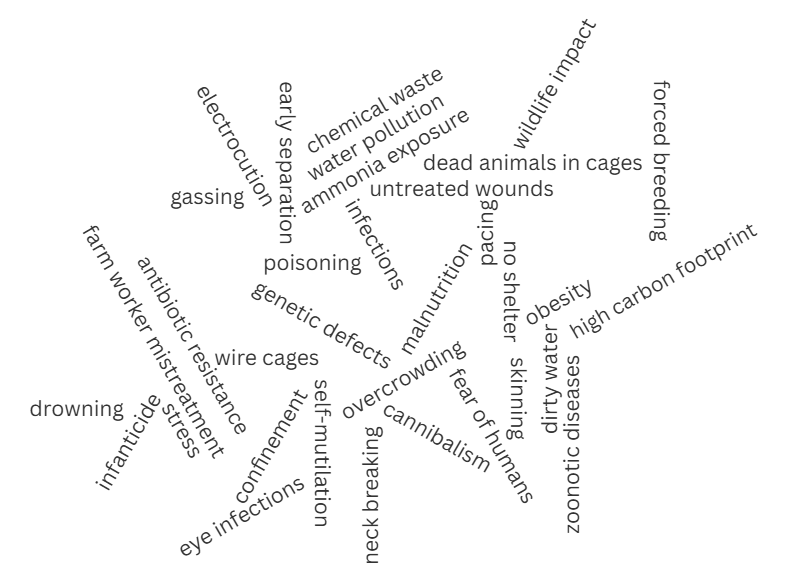
Fur Farming Brief
Does fur farming cause animal suffering?
Fur farms confine animals in small cages, causing severe distress, disease, and high mortality. Slaughter methods like gassing and electrocution are brutal yet legal. Beyond cruelty, fur farming poses public health risks and harms the environment. While the industry is declining, stronger legislation is needed. The WelFur certification is widely criticised as a misleading welfare standard.
Jump to:
Conditions on fur farms
Killing methods
Public health risks
Environmental impacts of fur
Fur certification and traceability schemes
Is fur growing or in decline?
Fur industry production data
Animals such as foxes are kept in small wire cages on fur farms, regularly suffering serious welfare problems as a result. This conditions are true on all fur farms, whether in Europe, North America or China (Finland, 2023)
Conditions On Fur Farms
Animals raised on fur farms—such as mink, foxes, chinchillas, and raccoon dogs—are subjected to conditions that starkly contrast with their natural behaviors. Typically, they are confined to small wire cages, where they are denied the ability to roam, burrow, swim (as in the case of semi-aquatic mink) or engage in social interactions as they would in the wild. This extreme confinement leads to severe physical and psychological distress, often resulting in self-mutilation, repetitive behaviors, and aggression among cagemates.
Furthermore, many fur farms are overcrowded and unsanitary, exacerbating the spread of disease and infection. Studies have documented high mortality rates due to stress-induced illness, injuries from fighting, and untreated wounds. The lack of veterinary care means that sick or injured animals often suffer prolonged agony before they die.
DOWNLOAD THE COMPREHENSIVE SCIENTIFIC REPORT ON FUR FACTORY FARMING WELFARE
Brutal Killing Methods
When animals on fur farms reach the end of their short lives, they face brutal and inhumane killing methods designed to preserve the quality of their pelts. Common practices include gassing, anal electrocution, neck-breaking, and even live skinning—each causing immense pain and suffering. These methods are widely condemned by animal welfare organisations and veterinary experts, yet they remain legal and standard practice in many fur-producing countries.
Fur Farms and Public Health Risks
Beyond animal welfare concerns, fur farms pose significant public health risks. Recent outbreaks of zoonotic diseases, including COVID-19 mutations in farmed mink, have highlighted the potential for fur farms to act as reservoirs for dangerous viruses. Overcrowded and unhygienic conditions facilitate the transmission of diseases between animals and humans, raising alarms among epidemiologists and public health officials.
Environmental Impacts
The environmental footprint of fur farming is another reason the industry faces mounting criticism. The production of fur garments requires large quantities of food, water, and land, making it significantly more resource-intensive than synthetic alternatives. Moreover, the chemicals used in fur processing, such as formaldehyde and chromium, contribute to toxic waste and pollution, harming ecosystems and local communities.
DOWNLOAD THE REPORT ON THE ENVIRONMENTAL IMPACT OF FUR
The Failures of the WelFur Certification Scheme
DOWNLOAD THE SCIENTIFIC REPORT ON THE FAILURES OF CAGE ‘ENRICHMENT’
The fur industry often cites the WelFur certification scheme as evidence of improved animal welfare standards. However, investigations and expert analyses suggest that this program falls far short of ensuring humane treatment. WelFur assessments are conducted on-site but often fail to address fundamental welfare issues, such as the psychological distress caused by cage confinement. The certification allows for small, barren cages that prevent natural behaviors, and it does not prohibit painful killing methods widely condemned by veterinarians.
Furthermore, WelFur assessments are frequently scheduled in advance, giving farms the opportunity to prepare for inspections rather than ensuring consistent, high-welfare conditions year-round. Many animal welfare organizations argue that the program serves more as a marketing tool to legitimize fur farming rather than as a genuine effort to improve the lives of farmed animals.
A Declining Industry
In response to growing ethical and environmental concerns, many countries and fashion brands are distancing themselves from the fur industry. Countries including the UK, Austria, and the Netherlands have banned fur farming outright, while major fashion houses such as Gucci, Prada, and Burberry have pledged to go fur-free. Additionally, consumer demand for ethical and sustainable fashion has surged, further pressuring the industry to change.
Action Is Still Needed
While the decline of fur farming is promising, the fight for animal welfare is far from over. Politicians need to take decisive steps to enact full fur production bans and sales bans, to bring an end to the inherent cruelty in the fur industry. Consumers can contribute by choosing cruelty-free alternatives and supporting legislative efforts to end fur farming globally.
The evidence is clear: fur farms are an outdated and inhumane industry that prioritises profit over animal welfare. As awareness grows, so does the urgency to dismantle this cruel practice and move toward a more ethical future for both animals and the planet.
Links & References
Hansen HO (2021) Global fur retail value. University of Copenhagen: Department of Food and Resource Economics. wearefur.com/wp-content/uploads/2021/06/Global-fur-retail-value-May-2021-Henning-study.pdf
Statistics Denmark (2022) PELS6: production of fur by species of animals. statbank.dk/PELS6
China Leather Industry Association (2024) Statistical report on the production of skins of mink, fox and raccoon in China (2022). https://www.chinaleather.org/front/article/131902/
China Leather Industry Association (2023) Statistical report on the production of skins of mink, fox and raccoon in China (2022). https://shorturl.at/aowxY
China Leather Industry Association (2014-2023) Statistical report on the production of skins of mink, fox and raccoon in China: https://drive.google.com/drive/folders/1eZaco5FwSq3cx93UZTOHhjpS2B8ziXa5?usp=drive_link
Deputy Chief Veterinarian Poland (2022): https://drive.google.com/file/d/13j2AwsfD6fLUFiAlLps_84U68lhZidY-/view?usp=sharing
Finnish Fur Breeders Association (FiFUR) (2023):https://fifur.fi/en/statistics-2023
Statistics Canada (2021) Supply and disposition of mink and fox on fur farms: table 32-10-0116-01. Released 28 October 2021. doi.org/10.25318/3210011601-eng
USDA (2024) Agricultural Statistics Board, United States Department of Agriculture. https://downloads.usda.library.cornell.edu/usda-esmis/files/2227mp65f/bv73dq14z/4m90gm526/mink0724.pdf
Federal Statistics Russia (2024) Federal Service for State Statistics. fedstat.ru/indicator/42321
Fur Farming Data Visuals
Understand the data on fur farming via our infographics.
Farmed fur production in 2023, by country
Mink fur production 2010 - 2023 (x1000)
Fox fur production 2010 - 2023 (x1000)


